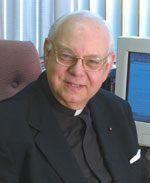Feast of the Assumption of the Blessed Virgin Mary / Msgr. Owen F. Campion
The Sunday Readings
 The Book of Revelation is the source of the first reading on this feast of the Assumption of Mary.
The Book of Revelation is the source of the first reading on this feast of the Assumption of Mary.
Catholics remember Revelation by its more historic name, at least in Catholic biblical translations, of Apocalypse.
Protestant editions of the Bible long ago began to title this book Revelation, which has become a more popular name. Now that name even appears in Catholic translations of the Scriptures.
However, Apocalypse is a better term for the book in that it describes the style of literature, a highly symbolic, poetic way of writing.
Unfortunately, the magnificence and hopefulness of the Book of Revelation too often is obscured by an uninformed and often outlandish misreading of this book as if it were all about doom and gloom.
In any case, this book looks to the present, but with a strong look to the future. It speaks of the battles between good and evil, between God and the forces of sin.
It speaks in the sense that the Redeemer has come, but redemption is still being achieved. It speaks with an awareness of the ultimate triumph of good over evil, life over death, and God over sin and despair. Good always prevails.
In this reading, the “woman clothed with the sun” is, on one level of interpretation, the Church, the virgin bride of Christ. The very light of God envelops the Church. Twelve stars, perhaps representing the holy Apostles, surround her head. Nature, represented by the moon, is at her feet.
Christians over the years also have seen Mary, the mother of Jesus, in this description. Ever virtuous and faithful, assumed into heaven, brilliant in her holiness, Mary stands before us as a “woman clothed with the sun” and living in the heavens.
St. Paul’s First Epistle to the Corinthians is the source of the second reading.
It recalls that Christ has been raised from the dead. But Christians loyal to Christ also will be raised from everlasting death. Actually, when the material world will cease, the eternal world of God will endure. There, the faithful Christians will live with Christ forever.
For its last reading on this feast, the Church presents the Gospel of St. Luke.
This Gospel passage provides a magnificent recollection of the prayer spoken by Mary as she arrived at the home of Elizabeth and Zechariah. It is the “Magnificat.”
The passage reveals much about Mary.
First, it shows her as the human mother of the Son of God.
Second, it reveals her holiness. Mary knew her calling. She knew the divine identity of her unborn child. She offers prayers to God.
Mary is part of God’s historic unfolding of salvation, first offered long ago through Abraham, Moses and the prophets. She is the final and, most important, solely human instrument in the fulfillment of Redemption.
Reflection
This weekend, the Church celebrates the Feast of the Assumption of the Blessed Virgin Mary into heaven.
Pope Pius XII infallibly declared this belief to be an essential Catholic belief in 1950. However, the origins of this doctrine date back to the earliest days of Christianity.
The Assumption ultimately illustrates Mary’s uniquely privileged position in the unfolding of salvation.
From her, the Redeemer acquired human nature, and only from her. Thus, Mary was indispensable to the Incarnation, a miracle essential to Redemption itself.
Furthermore, Mary was the holiest and most perfect of humans, “full of grace,” to quote Luke’s Gospel.
She literally was the first Christian, both in chronology and in the perfection of her virtue.
Fittingly, she received the reward of spiritual and bodily resurrection.
These readings remind us that eternal life, and indeed resurrection of the body and soul, await those who truly love the Lord. One day, if we follow Christ, we too will be assumed into heaven. †
 The Book of Revelation is the source of the first reading on this feast of the Assumption of Mary.
The Book of Revelation is the source of the first reading on this feast of the Assumption of Mary.